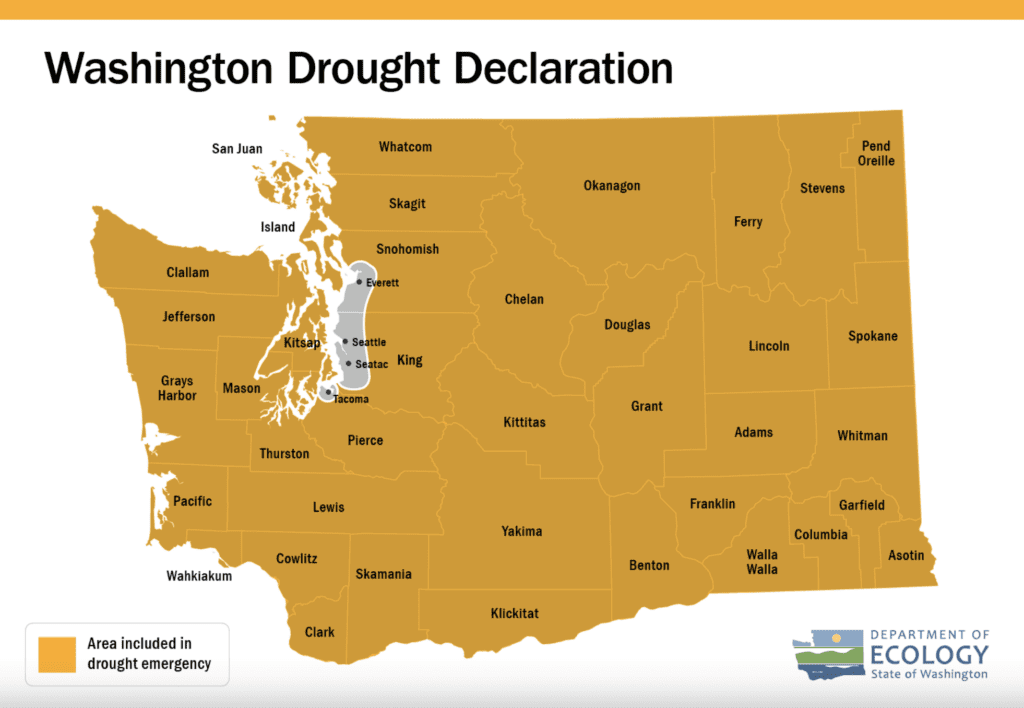It’s Not Enough – Statewide Drought Declared
A westward glance from hilltops in eastern Jefferson County reveal a stunning mountain horizon blanketed in a white cap of snow. But the truth lies in plain site: It’s not enough.
 The WA State Dept of Ecology has declared a statewide drought emergency due to the low snowpack and a dry forecast for spring/summer of 2024. Seattle, Tacoma, and Everett are not considered at drought stage due to their full reservoirs and low agriculture pressure. Drought impacts us all here in our beautiful corner of the world and it means we all must be mindful of our water usage and work to conserve wherever we can.
The WA State Dept of Ecology has declared a statewide drought emergency due to the low snowpack and a dry forecast for spring/summer of 2024. Seattle, Tacoma, and Everett are not considered at drought stage due to their full reservoirs and low agriculture pressure. Drought impacts us all here in our beautiful corner of the world and it means we all must be mindful of our water usage and work to conserve wherever we can.
Statewide, WA snowpack sits at 68%, but in our backyard the Olympics received far less, with snowpack ~50% of normal. Precipitation, snow water and rainfall included, the snow measurement sites in the Olympics are significantly better at around 84% since October 1.
Annual precipitation on the Olympic Peninsula varies widely, with heavier amounts occurring mostly in the mountains and their west (wet?) side of the range. Why? Fall and winter storms with moisture-laden clouds off the ocean, ascend the windward—typically southwest facing side of the Olympics–and drop most of their moisture there. On the leeward or northeastern side, as the air descends it dries, resulting in one of the nation’s driest west coast communities north of Ventura, California. This so-called Olympic Mountain “rainshadow” is profoundly influential across much of Puget Sound, including Seattle, which annually gets far less precipitation than virtually all major East and Gulf Coast cities. But nowhere is the drying influence of the Olympic rainshadow greater than in East Jefferson and Clallam Counties. Generally, we don’t have a lot of fresh water to start with even in “normal” years. And clearly, this isn’t a normal year.
All PUD-owned water systems rely on lowland precipitation recharging groundwater, not on annual mountain snowpack. Precipitation in the form of rainfall and lowland snow percolates down into aquifers where it can serve as storage, discharge to streams and to tidewater. In between, that water can be pumped and used by us. In some cases, water can be used multiple times before discharging to seawater. By moving very slowly from raindrop to seawater, groundwater systems are naturally more resistant to short-term droughts than those dependent on surface water. In this situation, the advantage goes to groundwater systems.
The Dept of Ecology notice is essentially an extension and broadening of the 2023 drought declaration. With an El Niño weather pattern still hanging around, bringing warm, dry conditions to the region, the declaration is scheduled to last into 2025. However, an encouraging seasonal forecast anticipates a transition to cooler and wetter La Niño conditions before the turn of the New Year.
Click here for a link to the full WA State Dept of Ecology release.
The Seattle Times looked at snowpack statewide and focused heavily on the lackluster winter here on the Olympic Peninsula. Click here to read.
Remember, every drop counts! Be sure to check out our water conservation tips here:
https://www.jeffpud.org/water-wisely/
